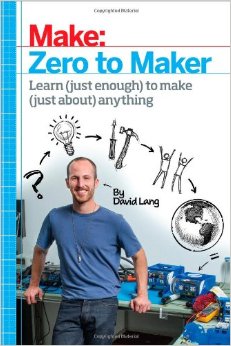Last week I reviewed the book TinkerLab which I found to be a required reading for anyone looking to work with students in creativity, problem solving, and developing that maker attitude.
I would like to add another essential reading to the collection and that is the book, Zero To Maker, written by David Lang.
I consider myself a maker wannabe and newbie. I am learning a great deal this year in both my personal adventures as well as operating a engineering program for students after school.
Reading this book reminded me that we all start from somewhere. The book basically follows David and his journey with this underwater robot and how it all came to be. Along the way he breaks down resources, how to connect with others, types of tools, tips, and other great ideas to help anyone get started. This is not a manual for each tool and resource. Rather it reads like a story and it is up to you to figure out what your next steps will be.
I wrote down a bunch of notes in my Make notebook(notebook only used for Maker ideas and development projects) that I can go back and reference as I continue to learn more and more.
A key part to this book was his emphasis on what is important. There are so many new tools and devices being created and promoted. At the end of the day you can start small with the tools that brought us up to this point. Start with what you have. Don’t feel like you have to have it all. Don’t worry about knowing everything. David talks many times about seeking help, going to the experts, and learning from the best. Asking for help is a quality that we must all have and many of us are afraid to ask for help.
Overall, his story is an example of his message. We must share and continue to help one another explore, learn from mistakes, and keep that growth mindset. This is a great read to get you started. The best part was it was not a tutorial. It is about the message that anyone can be maker. We are all makers in some aspects and we can develop at our own pace and our way to accomplish what we want to do.
Finally, something that I think gets lost in the many discussions of Makers, DIY, Makerspaces, etc. is that it is a team sport. I love the book when he states that making is not actually a DIY(Do It Yourself), but DIT(Do It Together). Making is a team sport that requires a community to do things. I witness this with every engineering lab where students work together to work through problems whether it is soldering, coding, or building ancient engineering weapons.


Leave a Reply